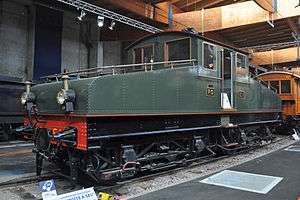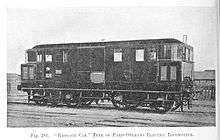SNCF BB 1280
The SNCF BB 1280 class were a class of 600 V DC 4 axle Bo′Bo′ electric locomotives, formerly Compagnie du chemin de fer de Paris à Orléans machines (originally PO E.1 to E.13), initially built for an underground section of line connecting the Gare d'Austerlitz to the Quai d'Orsay in inner Paris. The locomotives were converted for 1500 V DC use in the 1930s, and renumbered PO E.281 to E.293. They were absorbed by the SNCF, and operated as shunters until the late 1960s.
| PO E 1-13, later PO E 281-293 SNCF BB 1280 | |||||||||||||||||||||||||
|---|---|---|---|---|---|---|---|---|---|---|---|---|---|---|---|---|---|---|---|---|---|---|---|---|---|
 PO E.1 (preserved at Mulhouse railway museum, 2012)[lower-roman 1] | |||||||||||||||||||||||||
| |||||||||||||||||||||||||
| |||||||||||||||||||||||||
| |||||||||||||||||||||||||
| |||||||||||||||||||||||||
| |||||||||||||||||||||||||
History
At the end of the 19th century the Compagnie du chemin de fer de Paris à Orléans (PO) was seeking to extend its railway into a more central location in Paris: an extension from the Gare de Austerlitz to the new Gare du Quai d'Orsay was constructed, including covered sections; the new section was similar to the recently constructed Baltimore Belt Line (USA), constructed by the Baltimore and Ohio Railroad (B&O) and operated by electric locomotives built by General Electric, which had worked well, and achieved speeds of 80 km/h.[1][8]
Eight locomotives were ordered for the new line, delivered between 1900 and 1904, numbered E1 to E8, with electrical equipment from GE, and mechanical equipment and structural parts manufactured by Blanc-Misseron. The line was electrified by 600 V DC, supplied by a third rail, with overhead collection via a mini-pantograph in the Orsay tunnel.[1][2] Unlike the B&O locomotives the PO units used geared drive, rather than the co-axial gearless motor drive of the 1896 B&O machines.[1][9][10][11]
Locomotive E.1 was exhibited at the 1900 Exposition Universelle in Paris.[12]

The first eight units were a single cab steeplecab design.[1] Further units were acquired as the system's electrification spread beyond the initial Orsay-Austerlitz line;[13] five units were acquired, with a twin cab design, with a baggage compartment (locomotives-fourgon).[1][lower-roman 2]
In service the locomotives were used throughout the PO system where electrified; the initial specifications of the design, matching those used for the tunnel shuttle service on the Baltimore Belt Line were too low geared for the general network, and in 1904 seven locomotives were upgeared and the top speed raised to 100 km/h.[1][lower-roman 3][lower-roman 4]
In the late 1920s/1930s 1500 V DC began to be used on the PO rail system; the locomotives were converted for 1500 V operation at workshops at Vitry-sur-Seine using a Metadyne for traction control. A new pantograph as well as sand boxes were added. After conversion the class were renumbered E.281 to E.293.[lower-roman 5] During the second half of the units operational life they were used for shunting at depots to the southwest of Paris.[1][4]
In 1949 the units were renumbered BB 1280 to BB 1293 as part of the SNCF. The class were withdrawn between 1965-7.[1][4]
One unit, numbered E.1 is preserved at the Musée français du chemin de fer in Mulhouse.[2][6][lower-roman 1]
Models
Tin plate version of the locomotive were manufactured by Maerklin in Gauge I, and by Bing, LR, and Jouet de Paris (Jep) in Gauge 0.[15]
Kit versions have been produced by Maison des Trains, Pullman, RMCF Keyser,[15] and Apogée Vapeur in HO scale.[16][17]
See also
- LNER Class ES1, steeplecab electric locomotive originally built for the North Eastern Railway, also derived from the GE design
Notes
- The locomotive preserved was formerly BB1283, ex- PO E.2[6]
- During the second world war number 1292 (ex-PO E.12) was damaged and rebuilt as a single cab machine.[1][7]
- Unit E.1 was not upgeared, being assigned to shunting work in Orsay.[6]
- The original gear ratio was 4.1 (79 to 18) reduction, this was reduced to a 2.23 reduction gearing for higher speed. The locomotives supplied after the original eight had a 2.23 ratio as built.[14]
- Renumbering was did not preserve number order.[6]
References
- "LES BB 1281 à 1288 "BOITES A SEL" et BB 1289 à 1293 de la S.N.C.F.Du réel à la miniature", A - PETIT HISTORIQUE DE LA SERIE BB 1281-1288 et 1289-1293
- "Locomotive électrique E1 " Boîte à sel "", citedutrain.com (in French)
- Parshall & Hobart (1907), "Paris-Orleans Locomotives", p.325.
- BB 1280 ex E 1 à 13 PO (in French), Trains d'Europe
- "LES BB 1281 à 1288 "BOITES A SEL" et BB 1289 à 1293 de la S.N.C.F.Du réel à la miniature", C - CARACTERISTIQUES TECHNIQUES:
- Boîte à Sel BB E1-8 du PO (in French), Apogée Vapeur
- Boîte à Sel : locomotive fourgon PO E9-13 (in French), Apogée Vapeur
- Christopher T. Baer, "1900 : March 2005 Edition" (PDF), A GENERAL CHRONOLOGY OF THE PENNSYLVANIA RAILROAD COMPANY PREDECESSORS AND SUCCESSORS AND ITS HISTORICAL CONTEXT, The Pennsylvania Railroad Technical & Historical Society, May 28, 1900
- Parshall & Hobart (1907), pp. 307–310, The Baltimore and Ohio 1896 Gearless Locomotives.
- Parshall & Hobart (1907), pp. 319–325, Paris-Orleans Locomotives.
- Exposition Universelle Interantionale de 1900 à Paris : Groupe VI : Génie civil : Moyens de transport : Troisième partie. Classes 32 (Tome II). Classes 33 et 34 : Locomotive électrique E 1 des chemins de fer de Paris-Orléans, p.374
- Exposition Universelle Interantionale de 1900 à Paris : Groupe VI : Génie civil : Moyens de transport : Troisième partie. Classes 32 (Tome II). Classes 33 et 34 : Locomotive électrique E 1 des chemins de fer de Paris-Orléans
- Parshall & Hobart (1907), p. 323, Paris-Orleans Locomotives.
- Parshall & Hobart (1907), pp. 322–324, Paris-Orleans Locomotives.
- "LES BB 1281 à 1288 "BOITES A SEL" et BB 1289 à 1293 de la S.N.C.F.Du réel à la miniature", D - LES REPRODUCTIONS EN HO DES BOITES A SEL:
- Solde Boîte à sel PO E1-8 Origine RP25-88, Apogée Vapeur, retrieved May 2012 Check date values in:
|accessdate=(help) - Réservation locomotive fourgon PO E9-13 (in French), Apogée Vapeur, retrieved May 2012 Check date values in:
|accessdate=(help)
Sources
- Parshall, H.F.; Hobart, H.M. (1907). "IX. Locomotives and Motor Carriages and their Electrical Equipment". Electric Railway Engineering. Nature. 75. Archibald Constable & Co. pp. 291–479. Bibcode:1907Natur..75..531.. doi:10.1038/075531a0., alt. source
- "Locomotive électrique E 1 des chemins de fer de Paris-Orléans". Groupe VI : Génie civil : Moyens de transport : Troisième partie. Classes 32 (Tome II). Classes 33 et 34. Exposition Universelle Interantionale de 1900 à Paris : Rapports du jury international (in French). Ministère du Commerce, de l'Industrie des Postes et des Télégraphes. 1902. pp. 372–4.
- "LES BB 1281 à 1288 "BOITES A SEL" et BB 1289 à 1293 de la S.N.C.F.Du réel à la miniature", www.bzt87.com (in French), archived from the original on 2012-04-08
External links
| Wikimedia Commons has media related to SNCF Class BB 1280. |
- "ELECTRIC LOCOMOTIVES FROM OLD RAILWAYS COMPANIES AND THEIR FAMILIES : SNCF", www.mlgtraffic.net